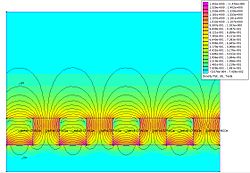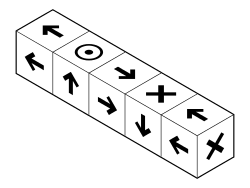A Halbach array is a special arrangement of permanent magnets that augments the magnetic field on one side of the array while cancelling the field to near zero on the other side.[1][2] This is achieved by having a spatially rotating pattern of magnetisation.
The rotating pattern of permanent magnets (on the front face; on the left, up, right, down) can be continued indefinitely and have the same effect. The effect of this arrangement is roughly similar to many horseshoe magnets placed adjacent to each other, with similar poles touching.
The principle was first invented by James (Jim) M. Winey of Magnepan in 1970, for the ideal case of continuously rotating magnetization, induced by a one-sided stripe-shaped coil.[3]
The effect was also discovered by John C. Mallinson in 1973, and these "one-sided flux" structures were initially described by him as a "curiosity", although at the time he recognized from this discovery the potential for significant improvements in magnetic tape technology.[4]
Physicist Klaus Halbach, while at the Lawrence Berkeley National Laboratory during the 1980s, independently invented the Halbach array to focus particle accelerator beams.[5]

The flux diagram of a Halbach array
https://en.wikipedia.org/wiki/Halbach_array
https://en.wikipedia.org/wiki/Linear_motor#Rapid_transits_using_linear_motor_propulsion
https://en.wikipedia.org/wiki/Linear_motor

No comments:
Post a Comment